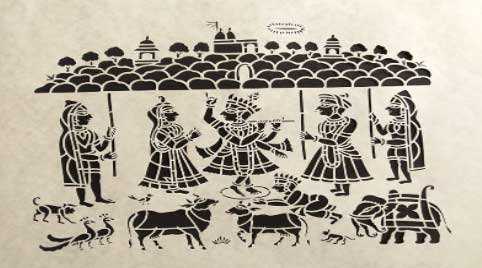Sanjhi Art is a beautiful and intricate form of Indian art that has been practiced for centuries. Originating in the temples of Mathura, this art form involves the creation of delicate paper stencils, which are used to create stunning designs on various surfaces.
History of Sanjhi Traditional Art

Artist: Love Kumar Soni Source from: http://sakoyafoundation.com
Sanjhi Traditional Art has its roots in the Hindu temples of Mathura and Vrindavan in Uttar Pradesh, India. It dates back to the 16th century when it was used to depict scenes from the life of Lord Krishna. The name “Sanjhi” is derived from the Hindi word “Sanjh,” meaning dusk, which is the time when this art form is traditionally created. The artisans, known as “Sanjiwalas,” would prepare the intricate stencils during the day and create the designs in the evening.
Techniques of Sanjhi Traditional Art
The process of creating Sanjhi is meticulous and requires great skill and patience. Here are the basic steps involved:
- Design Creation: The artist begins by sketching a design on paper. These designs often depict religious motifs, mythological stories, and nature scenes.
- Stencil Cutting: Using fine scissors, the artist carefully cuts out the design to create a stencil. This is the most crucial part of the process, as the beauty of the final artwork depends on the precision of the stencil.
- Application: The stencil is then placed on a surface, which could be a wall, floor, or any other medium. Colored powders, flowers, or leaves are sprinkled over the stencil to create the final image.
- Finishing Touches: Once the design is complete, the stencil is gently lifted to reveal the intricate pattern.
Cultural Significance of Sanjhi Traditional Art
Sanjhi is not just an art form but a way of preserving cultural and religious traditions. It plays a significant role in Hindu festivals, especially during the festival of Navratri. The intricate designs are created in temples and homes to welcome the goddess Durga. It also serves as a form of storytelling, passing down legends and religious stories through generations.
Modern Adaptations of Sanjhi Art
In recent years, Sanjhi Traditional Art has found a new lease of life. Contemporary artists are experimenting with new materials and techniques, taking this traditional art form beyond its religious roots. Today, this art can be found in modern homes, galleries, and even fashion designs. Its delicate patterns and intricate details continue to captivate art lovers around the world.
FAQ
What is Sanjhi Art?
Sanjhi Art is a traditional Indian art form that involves creating intricate designs using paper stencils. It originated in the temples of Mathura and Vrindavan and is often used to depict scenes from the life of Lord Krishna.
How is Sanjhi Art created?
The artist sketches a design on paper, cuts it out to create a stencil, and then uses the stencil to create patterns on a surface using colored powders, flowers, or leaves.
What is the cultural significance of Sanjhi Art?
Sanjhi Art holds great cultural and religious significance in India. It is used in Hindu festivals, especially Navratri, to welcome deities and tell religious stories through its intricate designs.
How can I learn Art?
Learning any art requires patience and practice. You can Areawala Art online class and learn Sanjhi Art form in 1 to 1 classes.
Conclusion
Sanjhi Art is a testament to the rich cultural heritage of India. Its intricate designs and historical significance make it a timeless tradition that continues to inspire and captivate people around the world. Whether you are an art lover or someone looking to explore traditional Indian art forms, Sanjhi Art is a beautiful journey worth embarking on.
View India’s popular art form
- Madhubani Painting: Also called Mithila Painting. Vibrant folk art from Bihar, known for intricate patterns and storytelling.
- Warli Art: Tribal art form from Maharashtra, characterized by simplistic yet expressive depictions of daily life.
- Tanjore Painting: Classical South Indian art form renowned for its rich use of gold foil and vibrant colors.
- Kalamkari Painting: Ancient art form from Andhra Pradesh, using natural dyes and intricate storytelling on cloth.
- Mughal Painting: Detailed miniature paintings from the Mughal era, showcasing courtly scenes and historical events.
- Pattachitra Painting: Traditional art form from Odisha, featuring bold lines, vibrant colors, and mythological themes.
- Gond Painting: Tribal art form from Madhya Pradesh, celebrated for its vibrant colors and intricate patterns inspired by nature.
- Rajasthani Miniature Painting: Diverse styles of miniature paintings from Rajasthan, depicting courtly life, landscapes, and religious themes.
- Kerala Mural Painting: Elaborate and colorful murals found in Kerala’s temples and palaces, showcasing Hindu mythology and folklore.
- Thangka Painting: Tibetan Buddhist art form practiced in parts of India, revered for its spiritual significance and intricate details.
- Kangra Painting: Miniature painting style from Himachal Pradesh, known for its romantic themes and delicate brushwork.
- Pichwai Painting: Devotional art form from Rajasthan, depicting Lord Krishna and his various leelas.
- Kalighat Painting: Folk art from Bengal, characterized by simple lines, bold colors, and depictions of everyday life and deities.
- Mysore Painting: Traditional art form from Karnataka, known for its delicate brushwork and intricate details.
